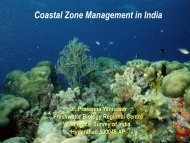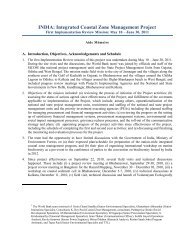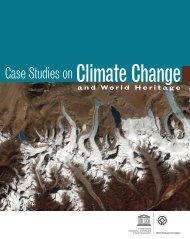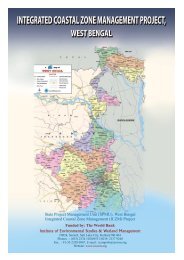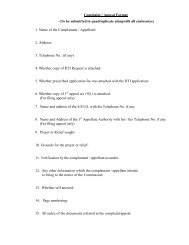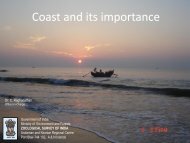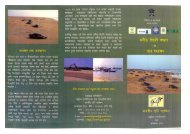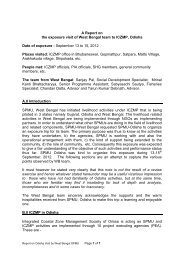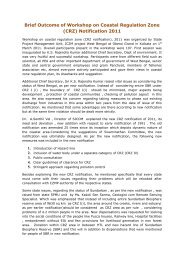Cyclone and Storm Surge - Iczmpwb.org
Cyclone and Storm Surge - Iczmpwb.org
Cyclone and Storm Surge - Iczmpwb.org
You also want an ePaper? Increase the reach of your titles
YUMPU automatically turns print PDFs into web optimized ePapers that Google loves.
6.6<br />
6.2.3. Construction Material<br />
The embankments in the Sundarban are built without using any heavy earth moving equipment.<br />
Transport from the borrow areas where the soils are excavated to the locations where the<br />
embankment is built or repaired is executed by labourers carrying buckets on their heads.<br />
Considering this system of transport <strong>and</strong> the expectation that the system will remain unchanged in<br />
the coming decade, the embankments have to be constructed with material found close by; at least<br />
the major part of their cross-section.<br />
At some locations excellent Clays or Silty Clays have been found, but at the majority of the soils are<br />
ranging from Fine S<strong>and</strong>y Loams to Silty Clay Loams; materials with less resistance against wavedash<br />
<strong>and</strong> scouring by current. Nevertheless these materials are suitable to be used for the construction<br />
of the embankments provided that they are taken from locations where these soils are<br />
sufficiently matured <strong>and</strong> properly consolidated. In practice however material to build or to repair the<br />
embankment is taken from the top layers of the berm between the river <strong>and</strong> the embankment or from<br />
the top soils of the adjacent rice fields, which cohesive qualities are strongly reduced by annually wet<br />
ploughing <strong>and</strong> puddling. These soils have to be qualified as mud or dried mud.<br />
Mud is a material with almost no cohesion <strong>and</strong> is less suitable to be used successfully for the<br />
construction of sustainable embankments. (The difference in quality of dried mud <strong>and</strong> matured loams<br />
can easily be demonstrated by putting a lump of each of the materials in separate buckets of water.<br />
After a couple of hours, even without stirring, there is nothing left from the lump of mud <strong>and</strong> on the<br />
bottom of the bucket is a layer of sediment. The lump of matured loam will show only small<br />
deformation.)<br />
The quality of an embankment largely depends on the proper choice of the material used for its<br />
construction. The difference in costs per unit length between an earthen embankment <strong>and</strong> an<br />
embankment of which the outer slope is protected by dry brick pitching is so large that the extra costs<br />
required to build the unprotected earthen bank of proper material are mostly more than justified.<br />
These better soils can often be found below the ploughing zone of the rice fields <strong>and</strong> in the<br />
embankments (or their remains) stability of which is no longer secured. The soils of the berms need<br />
to be examined carefully. Recent deposits should be avoided. If the soils of the outer berms are good<br />
enough to be used as construction material, the quantities should be taken from the zone closest to<br />
the edge of the river.







